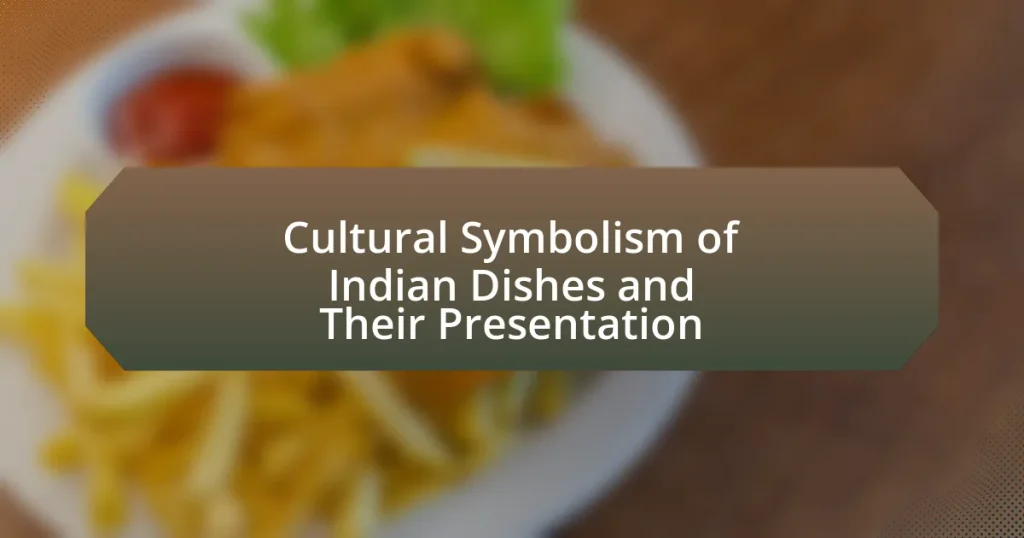The article explores the cultural symbolism of Indian dishes and their presentation, highlighting how these elements reflect the diverse traditions, rituals, and regional identities within India. It examines the significance of communal dining practices, the use of specific ingredients, and the vibrant presentation styles that enhance the dining experience. Additionally, the article discusses the influence of regional diversity on culinary practices, the role of festivals and rituals in food presentation, and the psychological effects of color in Indian cuisine. It also addresses modern trends and fusion styles that are reshaping traditional presentation techniques, providing practical tips for enhancing the visual appeal of Indian dishes at home.

What is the Cultural Symbolism of Indian Dishes and Their Presentation?
The cultural symbolism of Indian dishes and their presentation reflects the diverse traditions, rituals, and regional identities within India. Indian cuisine often symbolizes hospitality, with dishes served in a communal manner, emphasizing sharing and togetherness, which is a core value in Indian culture. For example, the use of thalis, which are large plates with various small bowls of different dishes, represents the idea of balance and harmony in flavors, showcasing the importance of variety in Indian meals. Additionally, the vibrant colors and intricate presentation of dishes, such as biryani or sweets during festivals, symbolize celebration and festivity, aligning with cultural practices that honor deities and mark significant life events. The use of specific ingredients, like turmeric for auspiciousness or ghee for purity, further reinforces the cultural significance embedded in the culinary practices of India.
How do Indian dishes reflect cultural values and traditions?
Indian dishes reflect cultural values and traditions through their diverse ingredients, preparation methods, and communal dining practices. The use of spices and regional ingredients showcases the geographical and agricultural diversity of India, while traditional cooking techniques, such as slow cooking and fermentation, highlight the importance of patience and craftsmanship in Indian culture. Additionally, many Indian dishes are tied to religious and seasonal festivals, emphasizing the role of food in rituals and celebrations. For instance, sweets like ladoos are often prepared during Diwali, symbolizing prosperity and joy. Furthermore, the practice of sharing meals, known as “langar” in Sikhism, underscores values of community and equality, reinforcing the idea that food is a unifying force in Indian society.
What role does regional diversity play in the symbolism of Indian cuisine?
Regional diversity is fundamental to the symbolism of Indian cuisine, as it reflects the varied cultural, historical, and geographical influences across the country. Each region in India has its unique ingredients, cooking techniques, and traditional dishes that symbolize local customs and heritage. For instance, the use of rice in South Indian cuisine signifies sustenance and community, while wheat-based dishes in the North represent agricultural practices and regional identity. This diversity not only showcases the rich tapestry of Indian culture but also serves as a medium for expressing social values, religious beliefs, and familial traditions, making Indian cuisine a profound symbol of regional identity and unity in diversity.
How do festivals and rituals influence the presentation of Indian dishes?
Festivals and rituals significantly influence the presentation of Indian dishes by dictating the use of specific colors, arrangements, and serving styles that reflect cultural symbolism. During festivals like Diwali, dishes are often presented in vibrant colors using decorative platters, symbolizing prosperity and joy, while rituals such as puja involve offering food in a particular manner to honor deities, emphasizing respect and devotion. For example, during Navratri, food is often arranged in a thali with specific items that represent purity and devotion, showcasing the cultural importance of the meal. This adherence to tradition in presentation not only enhances the visual appeal but also reinforces the cultural significance of the dishes served during these occasions.
Why is presentation important in Indian culinary culture?
Presentation is important in Indian culinary culture because it enhances the visual appeal and reflects the cultural significance of the dishes. In Indian tradition, food is not just sustenance; it is an art form that embodies the values, rituals, and aesthetics of the culture. For instance, the use of vibrant colors, intricate plating, and traditional serving styles showcases the diversity and richness of Indian cuisine, making it a feast for the eyes as well as the palate. This emphasis on presentation is rooted in historical practices where meals were often served during festivals and celebrations, highlighting the importance of food in social and cultural gatherings.
What are the traditional methods of presenting Indian dishes?
Traditional methods of presenting Indian dishes include the use of banana leaves, thalis, and decorative garnishing. Banana leaves are often used as eco-friendly serving plates, enhancing the flavor and aroma of the food while also being culturally significant in many regions of India. Thalis, which are large, round platters, typically feature a variety of small bowls containing different dishes, symbolizing the diversity of Indian cuisine and encouraging communal eating. Additionally, garnishing with fresh herbs, spices, or edible flowers is common, adding visual appeal and highlighting the dish’s ingredients. These methods reflect the cultural importance of food presentation in Indian traditions, emphasizing hospitality and the aesthetic experience of dining.
How does the visual appeal of a dish enhance its cultural significance?
The visual appeal of a dish enhances its cultural significance by serving as a representation of cultural identity and traditions. In Indian cuisine, for example, the vibrant colors and intricate presentation of dishes reflect regional diversity and historical influences, making the food not just a meal but a cultural artifact. Studies show that visually appealing dishes can evoke emotional responses and enhance the dining experience, reinforcing cultural narratives and communal bonds during meals. The use of specific colors and arrangements in Indian dishes often symbolizes various cultural meanings, such as auspiciousness or celebration, thereby deepening the connection between food and cultural practices.

What are the key elements of cultural symbolism in Indian dishes?
The key elements of cultural symbolism in Indian dishes include the use of specific ingredients, cooking methods, and presentation styles that reflect regional traditions, religious beliefs, and social customs. For instance, spices like turmeric symbolize purity and health, while ghee is associated with auspiciousness in Hindu rituals. Additionally, the arrangement of food on a thali represents balance and harmony, reflecting the importance of variety in Indian cuisine. These elements are deeply rooted in India’s diverse cultural heritage, where food serves not only as sustenance but also as a medium for expressing identity and community values.
How do ingredients contribute to the symbolism of Indian cuisine?
Ingredients in Indian cuisine symbolize various cultural, religious, and regional identities. For instance, spices like turmeric represent purity and health, while ingredients such as ghee are associated with auspiciousness and celebration in Hindu rituals. The use of lentils signifies sustenance and is a staple in many households, reflecting the agrarian roots of Indian society. Additionally, the incorporation of regional ingredients, such as coconut in South Indian dishes, highlights the geographical diversity and local traditions. These associations are deeply embedded in the culinary practices, showcasing how ingredients serve as a medium for expressing cultural values and beliefs.
What specific ingredients are considered auspicious in Indian cooking?
In Indian cooking, specific ingredients considered auspicious include turmeric, rice, and jaggery. Turmeric symbolizes purity and prosperity, often used in rituals and celebrations. Rice represents fertility and abundance, frequently featured in offerings and festive dishes. Jaggery, a natural sweetener, signifies sweetness in life and is commonly used in traditional sweets during auspicious occasions. These ingredients are integral to various cultural practices and are believed to bring good fortune and positive energy to meals and celebrations.
How do spices reflect the cultural heritage of India?
Spices reflect the cultural heritage of India by embodying the diverse regional traditions, historical trade routes, and culinary practices that shape Indian cuisine. Each spice, such as turmeric, cumin, and cardamom, carries historical significance; for example, black pepper was once so valuable that it was referred to as “black gold” and played a crucial role in establishing trade links between India and Europe. Furthermore, the use of spices in Indian cooking is deeply intertwined with religious and cultural rituals, where specific spices are associated with festivals and ceremonies, highlighting their importance in social and spiritual contexts. This rich tapestry of flavors and practices illustrates how spices are not merely ingredients but vital components of India’s cultural identity.
What is the significance of color in the presentation of Indian dishes?
The significance of color in the presentation of Indian dishes lies in its ability to evoke emotions, symbolize cultural meanings, and enhance the overall dining experience. Colors in Indian cuisine are not merely aesthetic; they represent various elements such as freshness, flavor, and even the occasion. For instance, vibrant colors like red and yellow often signify warmth and celebration, while green represents health and freshness. Additionally, the use of spices like turmeric and chili not only adds flavor but also contributes to the visual appeal, making dishes more inviting. This emphasis on color aligns with traditional Indian beliefs that associate specific colors with different deities and festivals, reinforcing the cultural importance of color in food presentation.
How do different colors in food symbolize various cultural meanings?
Different colors in food symbolize various cultural meanings by representing specific emotions, traditions, and beliefs within a culture. For instance, in Indian culture, saffron signifies purity and is often associated with spirituality, while green represents prosperity and freshness, commonly seen in dishes like palak paneer. Red is linked to love and celebration, frequently appearing in festive foods such as sweets and curries. These associations are rooted in historical practices and cultural narratives, where colors are not merely aesthetic but carry deeper significance, influencing how food is prepared, presented, and consumed during rituals and celebrations.
What are the psychological effects of color on the perception of Indian cuisine?
The psychological effects of color on the perception of Indian cuisine significantly influence how dishes are perceived and enjoyed. Colors such as vibrant reds, yellows, and greens evoke feelings of warmth, excitement, and freshness, enhancing the overall dining experience. Research indicates that red can stimulate appetite, while yellow is associated with happiness and energy, both of which are prevalent in Indian culinary presentations. For instance, the use of saffron in dishes not only adds flavor but also a rich golden hue that is visually appealing and culturally significant, symbolizing luxury and celebration in Indian culture. This interplay of color and psychology shapes diners’ expectations and satisfaction, reinforcing the cultural symbolism inherent in Indian cuisine.

How does the presentation of Indian dishes vary across different regions?
The presentation of Indian dishes varies significantly across different regions, reflecting local customs, ingredients, and cultural symbolism. For instance, in North India, dishes are often served in elaborate thalis, showcasing a variety of items that represent the region’s diverse culinary heritage, such as curries, breads, and sweets. In contrast, South Indian cuisine typically features meals served on banana leaves, emphasizing freshness and sustainability, with items like rice, sambar, and chutneys arranged in a specific manner to enhance the dining experience. Additionally, in West India, particularly in Gujarat, the use of colorful garnishes and the presentation of dishes like dhokla and thepla highlight the region’s festive spirit. Each regional presentation style not only serves aesthetic purposes but also embodies cultural values and traditions, making the dining experience a reflection of the area’s identity.
What are the regional variations in the presentation of Indian cuisine?
Indian cuisine exhibits significant regional variations in presentation, influenced by local ingredients, cultural practices, and historical contexts. For instance, in North India, dishes are often served in thalis, which are large plates with small bowls containing various items, reflecting a communal dining culture. In contrast, South Indian cuisine frequently features meals served on banana leaves, emphasizing freshness and eco-friendliness. Additionally, the use of vibrant spices and garnishes varies; for example, Rajasthani dishes are often presented with colorful chutneys and pickles, while Bengali cuisine highlights fish and rice, presented in a more minimalist style. These variations not only enhance the visual appeal of the food but also symbolize the diverse cultural identities across India.
How do cultural influences shape the presentation styles in different Indian states?
Cultural influences significantly shape the presentation styles of dishes across different Indian states by reflecting regional traditions, religious practices, and local ingredients. For instance, in Punjab, vibrant colors and elaborate platters are common, showcasing the region’s agricultural abundance and festive spirit, while in Kerala, the use of banana leaves for serving reflects the state’s connection to nature and traditional practices. Additionally, the presentation in West Bengal often emphasizes artistic arrangements, influenced by the state’s rich artistic heritage and the importance of aesthetics in Bengali culture. These variations in presentation styles are not only a matter of visual appeal but also serve to communicate cultural identity and values, as seen in the ritualistic serving of food during festivals and ceremonies across various states.
What are some unique presentation techniques used in specific regions?
Unique presentation techniques in specific regions include the use of banana leaves in South India, where dishes are served on the leaf to enhance flavor and symbolize hospitality. In Rajasthan, food is often presented in traditional brass or copper utensils, reflecting the region’s rich heritage. Additionally, in Bengali culture, the art of plating involves arranging food in a visually appealing manner, often using vibrant colors to represent the diversity of ingredients. These techniques not only enhance the dining experience but also convey cultural significance and tradition.
How do modern trends influence the traditional presentation of Indian dishes?
Modern trends significantly influence the traditional presentation of Indian dishes by incorporating contemporary aesthetics and innovative plating techniques. Chefs are increasingly adopting minimalist designs and artistic arrangements, moving away from the traditional, often elaborate presentations that emphasize communal sharing. This shift is evident in fine dining establishments where Indian cuisine is presented on sleek, modern tableware, enhancing visual appeal and elevating the dining experience. Additionally, the use of fusion elements, such as integrating global culinary techniques, further transforms the traditional presentation, making it more appealing to a diverse audience. This evolution reflects a broader trend in the culinary world where visual presentation is as crucial as taste, aligning with the growing emphasis on social media sharing and food photography.
What fusion styles are emerging in the presentation of Indian cuisine?
Emerging fusion styles in the presentation of Indian cuisine include Indo-Italian, Indo-Mexican, and Indian-inspired modernist cuisine. These styles blend traditional Indian flavors and cooking techniques with elements from other culinary traditions, creating innovative dishes that appeal to diverse palates. For instance, Indo-Italian cuisine often features pasta dishes infused with Indian spices, while Indo-Mexican cuisine incorporates ingredients like paneer into tacos. Additionally, modernist cuisine techniques, such as molecular gastronomy, are being applied to traditional Indian dishes, resulting in unique presentations and textures that enhance the dining experience.
How are contemporary dining experiences reshaping traditional presentations?
Contemporary dining experiences are reshaping traditional presentations by emphasizing visual aesthetics, interactive elements, and personalized service. Modern restaurants often prioritize plating techniques that transform dishes into artful displays, enhancing the visual appeal and encouraging social media sharing. For instance, the use of vibrant colors, unique textures, and innovative arrangements reflects a shift towards a more experiential dining approach. Additionally, interactive dining experiences, such as communal sharing or DIY elements, engage diners in the presentation process, making them active participants rather than passive observers. This evolution is supported by trends in gastronomy that highlight the importance of presentation in enhancing flavor perception and overall enjoyment, as evidenced by studies showing that visually appealing dishes can significantly influence diners’ satisfaction and willingness to pay.
What practical tips can enhance the presentation of Indian dishes at home?
To enhance the presentation of Indian dishes at home, use vibrant colors and traditional serving ware. The visual appeal of Indian cuisine is heightened by incorporating colorful ingredients like turmeric, red chili, and fresh herbs, which not only enhance flavor but also create an inviting look. Serving dishes in traditional Indian crockery, such as brass or clay pots, adds authenticity and cultural significance, reflecting the rich heritage of Indian dining. Additionally, garnishing with fresh cilantro, pomegranate seeds, or edible flowers can elevate the dish’s aesthetic, making it more visually appealing. These practices are rooted in the cultural symbolism of Indian cuisine, where presentation plays a crucial role in the dining experience.
